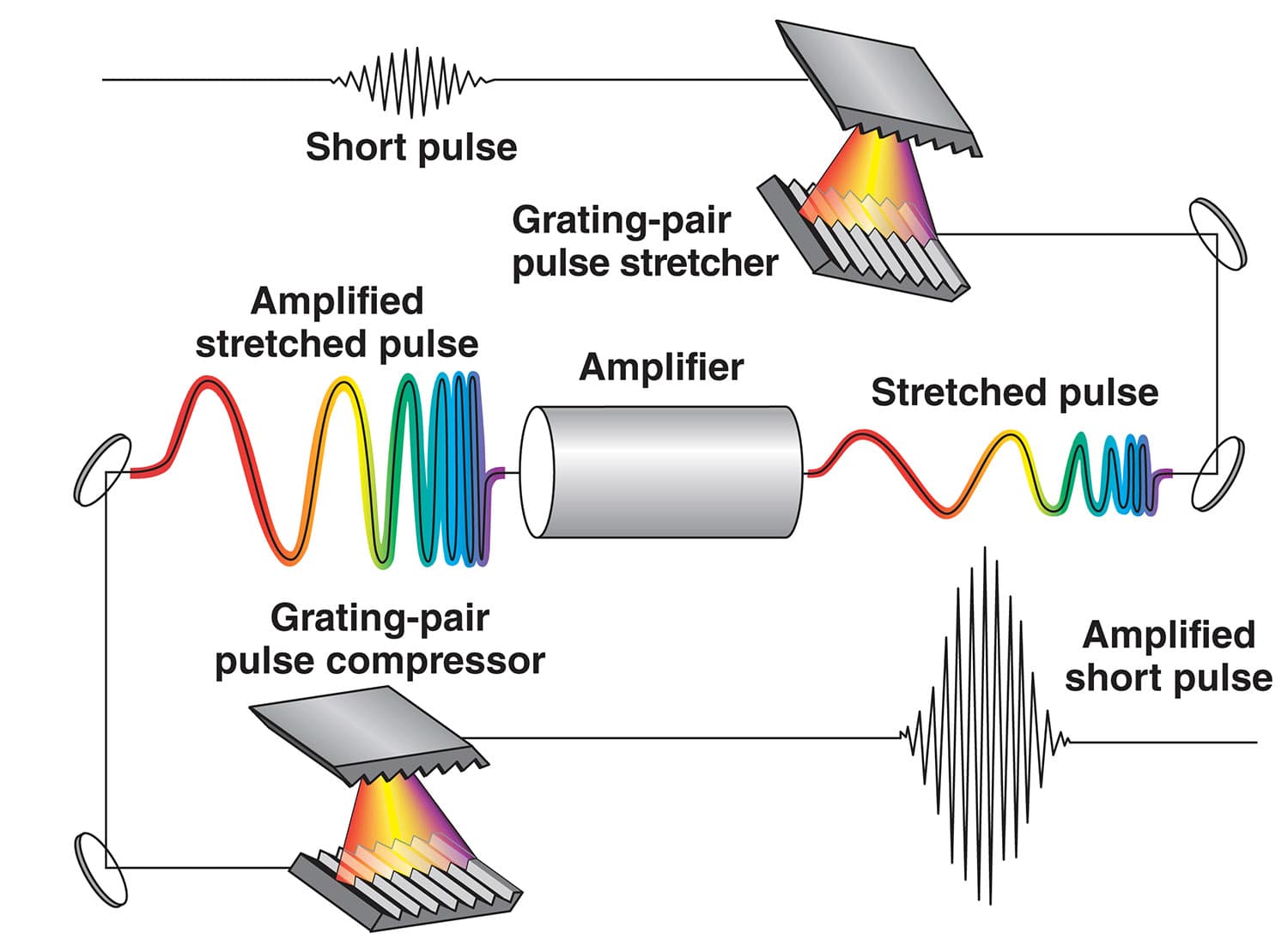Ultrashort pulses mark a key advancement on laser physics. They’re light pulses with durations at picoseconds or shorter. This lets us study ultrafast processes in matter with unmatched time resolution.
There’s no universal definition for “ultrashort.” But the term usually applies to pulses lasting up to tens of picoseconds. Often, they fall in the femtosecond range (10⁻¹⁵ seconds), pushing temporal measurement boundaries.
Ultrashort pulses mostly come from several advanced techniques. Passively mode-locked lasers stand as the most common method.Mode-locking sets a fixed phase relationship between longitudinal modes in laser cavity. When these modes sync, constructive interference forms extremely short pulses.
Other generation methods include optical parametric amplifiers (maybe using supercontinuum as input) and free-electron lasers. Each brings unique perks for specific uses.
Passive mode-locking is the most effective way to make ultrashort pulses. It puts a saturable absorber inside laser resonator.This absorber weakens lower-intensity light more, while letting higher-intensity peaks pass with little loss. It acts like a temporal filter, helping pulse formation.
When used on titanium-sapphire lasers with proper dispersion compensation, this technique can make pulses under 10 femtoseconds. That gets close to theoretical limit of just a few optical cycles.
You can start with longer pulses and use compression methods. But in most real cases, input pulses for such compression already lie in ultrashort regime.Compression techniques usually use specially designed setups of diffraction gratings or prisms. These manipulate different frequency components of pulse to get shorter durations.

Chirped pulse amplification (CPA) is a revolutionary technique to amp ultrashort pulses to extremely high powers. Its developers won Nobel Prize in Physics 2018.This method solves a key challenge: Directly amplifying ultrashort pulses would create intensities that damage optical parts.
In CPA, first stretch pulse temporally with diffraction gratings. Then amp at lower peak powers. Finally, recompress to nearly original duration but with much higher energy.

Ultrashort pulses naturally have wide optical bandwidths. This comes from fundamental link between temporal duration and spectral width, described by Fourier transform principles.Even if instantaneous frequency stays almost constant through pulse, spectrum width is at least around inverse pulse duration. This is a direct result of time-bandwidth product limitation.This relationship gets quantified by time-bandwidth product (TBP). It can’t be less than about 0.3–0.4, depending on pulse shape.
For example, a transform-limited (non-chirped) Gaussian pulse with duration of 1 picosecond (measured at full width at half maximum) shows an optical bandwidth around 0.44 THz.As pulses get shorter, their spectral bandwidth must increase. Few-cycle pulses might span an entire octave on frequency space.
Generating ultrashort pulses in mode-locked lasers involves various pulse shaping mechanisms that affect final temporal profile.One key element is saturable absorber. It has high losses at start or sometimes at end of pulse, effectively shaping its temporal form.
Beyond initial generation, ultrashort pulses can get further tweaked using specialized pulse shapers. These control their spectral and temporal traits.Advanced pulse shaping techniques use spatial light modulators or acousto-optic devices. They precisely control spectral phase and amplitude of each frequency component. This lets us create custom pulse shapes for specific uses.
These shaped pulses find use in coherent control experiments. There, precise temporal profile of electric field drives selective excitation pathways in atoms and molecules.
Accurately measuring ultrashort pulses brings big challenges. Their extremely brief durations go beyond response time of conventional electronic detectors.
Several specialized techniques got developed to characterize these pulses. They range from methods measuring basic params like pulse duration to advanced approaches giving complete electric field reconstruction.
The most common way to measure pulse duration is autocorrelation. It splits pulse into two replicas, introduces a variable delay between them, then recombines them in nonlinear medium.
The resulting signal, recorded as function of delay, makes an autocorrelation trace. Its width links to pulse duration by a factor depending on pulse shape.There are two main autocorrelation types: intensity autocorrelation, which gives info on pulse duration but not its phase; and interferometric autocorrelation, which is more sensitive to phase effects but still lacks full phase info.While autocorrelation techniques are fairly easy to use, they can’t uniquely determine pulse shape. They might mislead when analyzing noisy or complex pulse structures.
For more thorough pulse characterization—especially for extremely short pulses (under 10 femtoseconds)—advanced techniques like Frequency-Resolved Optical Gating (FROG) and Spectral Phase Interferometry for Direct Electric-field Reconstruction (SPIDER) prove more accurate and informative.These methods not only measure pulse duration but also give valuable phase info, enabling full reconstruction of electric field.
FROG records spectrum of an autocorrelation signal at various delay times, creating a spectrogram. This can be analyzed to pull out complete pulse traits.SPIDER uses spectral interferometry between two frequency-shifted replicas of pulse to directly measure spectral phase. Combined with spectrum, this lets full pulse reconstruction.
These advanced characterization methods offer big advantages for ultrashort pulse analysis. They include clear determination of pulse shape, insensitivity to intensity noise, and direct measurement on spectral domain.Results can be shown through various representations: time-dependent function plots, frequency-dependent plots, or spectrograms showing time-frequency info at once.
Unique properties of ultrashort pulses have enabled revolutionary apps across many scientific and tech fields.In materials processing, their extremely high peak intensities plus minimal heat damage to surrounding areas make them perfect for precision micromachining and nanofabrication.
Medical apps include ophthalmological procedures like LASIK surgery, where precise tissue removal with minimal collateral damage is key.In scientific research, ultrashort pulses have opened new frontiers in time-resolved studies of molecular dynamics, chemical reactions, and electron motion inside atoms and molecules.
1999 Nobel Prize in Chemistry went to work using ultrashort pulses to observe chemical reactions at their natural timescales, founding femtochemistry field.More recently, developing attosecond pulses (10⁻¹⁸ seconds) through high harmonic generation pushed temporal resolution even further. This lets direct observation of electron dynamics in atoms and molecules.
Another key app area is nonlinear optics. Extremely high peak intensities of ultrashort pulses efficiently drive nonlinear processes even at moderate pulse energies. This enabled advances in multiphoton microscopy, supercontinuum generation, and terahertz spectroscopy, among many techniques.
Ultrashort pulses stand as one of modern laser physics’ most significant achievements. They offer unmatched temporal resolution to study and manipulate matter.Their generation mainly relies on mode-locked lasers, with titanium-sapphire systems now holding record for shortest directly made pulses.
Fundamental limits on pulse duration get governed by time-bandwidth product, which sets link between temporal and spectral widths.Characterizing ultrashort pulses evolved from simple autocorrelation techniques to advanced methods like FROG and SPIDER, which give complete electric field reconstruction.
These advanced measurement abilities, combined with precise control over pulse params through shaping techniques, enabled numerous apps in science, medicine, and industry.As pulse generation and measurement tech keeps advancing, even shorter pulses with more precisely controlled traits will likely emerge. This will further expand frontiers of ultrafast science and tech.
Contact: Jason
Phone: +8613337332946
E-mail: [email protected]
Add: Hangzhou City, Zhejiang Province, China